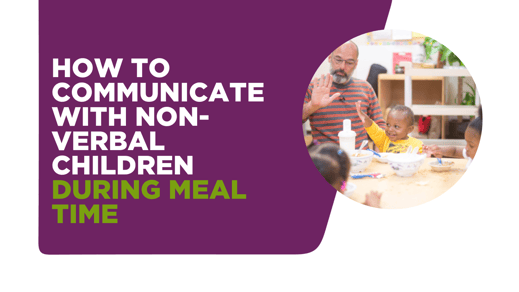
Children who are nonverbal are always communicating with us. In fact, according to Dr. Mehrabian, "93% of our communication is nonverbal in nature."
Yet, just because children who are nonverbal might not be speaking to us, educators can still have a reciprocal interaction. Try focusing on their facial expressions, following their gaze, and looking at what they pointing to. Interpret their input, and check for confirmation. Facilitate technological devices and apps that speak for them, and make available visuals they can use to show us what they want, think, need, fear, or are interested in.
Lunchtime might post a more challenging time to incorporate these ideas. Here are some additional ways to support nonverbal communication during mealtimes.
1. Engage in back-and-forth exchanges
Engage in back-and-forth exchanges, even when these exchanges are nonverbal on the part of the child. As you speak with children, they are always listening and observing your nonverbal communication and responding in their own way. Their communication may come across as smiles, excited clapping, eye contact, and pauses as they wait for your response.
2. Scaffold answers by offering choices
Scaffold the answers by offering two choices. For example, "Would you like apples or pears?"
Follow up when they choose, "Oh, you want a pear! I wonder why you chose a pear today. Is it sweeter? Is it because you want a yellow fruit today?"
Pause and look attentively as the child responds non-verbally. Add your own likes: "I like apples better than pears. Do you want to know why?"
Pause, look at the response, and follow up should the child is interested: "Well, pears feel grainy in my mouth. Do you know what grainy means? They feel like sand in my mouth, and I do not like that feeling."
Maybe the child's expression changed when you said "sand." Use this response: "You like sand? Do we eat sand? Why not? What can we do in the sand?"
The conversations are likely to extend to several children at the table, engage, these conversations will be endless as you persist.
3. Encourage children to Respond In Other Ways
You can incorporate movement in children’s responses even while sitting at the table. Consider asking them to raise their hand to questions you can ask throughout mealtime. Some questions to consider could include:
- Do you like your food today?
- Have you visited a farm before?
- Did anyone help pick out your food at the grocery store?
Engage in reciprocal interactions by mentioning things they might have seen so that they can respond based on their own experiences.
4. Use pictures
Consider sharing pictures with children so they can choose the conversation topic at the table. Topics could include their family, their pets, how foods grow, etc. What other pictures might you want to add to help them communicate their needs during mealtime? Things like: more food, I’m full, I need help can be useful cards to make meals easier.
5. Be an authentic interpreter
Always double-check that what you think they’re communicating is what they mean. For example, if a child points to their water, check that they’re asking for more. They could mean they’re looking for a different drink or they might not like they cup you’ve offered them. It’s always a good idea to watch their reactions as you ask for confirmation.
6. Be Silly
Be silly while providing information. Children don’t need to be verbal to enjoy silly moments with their educators. Here’s a silly example:
“What do you think we are going to eat for lunch?”
Pause to gauge interest.
“Are we having grass?”
Laugh and smile
“No? Why don’t we eat grass? Who eats grass? Why can they eat grass, and we cannot?”
7. Include more than one child
Remember to include other children in their conversations. For example, say, "Show your friend what food on your plate you like the most." When the child points at the food, call out the food and prompt the child to repeat, "Can you say carrot so that your friend hears you?"
With these tips, you’ll be on your way to making meals more memorable for every child in your program. What other examples would you share? Join our CLASS Learning Community for free to share tips with other educators around the world!

